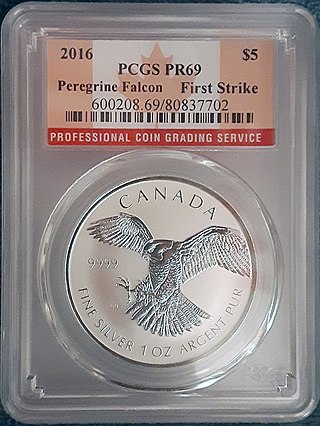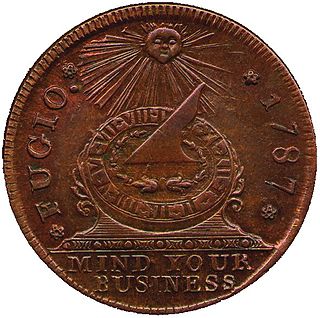This article needs additional citations for verification .(August 2020) |
The American Numismatic Association Certification Service, better known as ANACS, is a coin grading company founded in 1972. [1]
This article needs additional citations for verification .(August 2020) |
The American Numismatic Association Certification Service, better known as ANACS, is a coin grading company founded in 1972. [1]
Originally founded in June 1972 as the American Numismatic Association's authentication service, ANACS expanded into third-party coin grading in March 1979. ANACS was founded in response to the rise in counterfeit and altered coins in the numismatic marketplace. During the coin collecting boom of the 1960s, counterfeiters would alter common-date coins, and either add or remove a mintmark in order to sell the coins as their more-valuable counterparts. (For example, an 'S' mint mark would be added to a 1909 VDB Lincoln cent in order to increase the coin's value by making collectors think it was a genuine 1909-S VDB cent). [2] ANA sold ANACS to the publisher of Coin World in 1989, and it has since been resold. [1]

1943 steel cents are U.S. one-cent coins that were struck in steel due to wartime shortages of copper. The Philadelphia, Denver, and San Francisco mints each produced these 1943 Lincoln cents. The unique composition of the coin has led to various nicknames, such as wartime cent, steel war penny, zinc cent and steelie. The 1943 steel cent features the same Victor David Brenner design for the Lincoln cent which had been in use since 1909.

Coin grading is the process of determining the grade or condition of a coin, one of the key factors in determining its collectible value. A coin's grade is generally determined by six criteria: strike, preservation, luster, color, attractiveness, and occasionally the country/state in which it was minted. Several grading systems have been developed. Certification services professionally grade coins for tiered fees.

The American Numismatic Association (ANA) is an organization founded in 1891 by George Francis Heath. Located in Colorado Springs, Colorado, it was formed to advance the knowledge of numismatics along educational, historical, and scientific lines, as well as to enhance interest in the hobby.

The Numismatist is the monthly publication of the American Numismatic Association. The Numismatist contains articles written on such topics as coins, tokens, medals, paper money, and stock certificates. All members of the American Numismatic Association receive the publication as part of their membership benefits.

A key date is a term used in coin collecting and it refers to a date of a given coin series or coin set that is harder to obtain than other dates in the series. A key date coin is usually one with a lower mintage total and it is more valuable than others in the series. Many coin collectors collect coins to fill out a complete set of a series.
Third-party grading (TPG) refers to coin grading & banknote grading authentication, attribution, and encapsulation by independent certification services.

Quentin David Bowers is an American numismatist, author, and columnist. Beginning in 1952, Bowers’s contributions to numismatics have continued uninterrupted and unabated to the present day. He has been involved in the selling of rare coins since 1953 when he was a teenager.
The Chester L. Krause Memorial Distinguished Service Award is the highest honor conferred by the American Numismatic Association. The award was formerly named after Farran Zerbe, a one-time president of the American Numismatic Association. It is given in recognition of numerous years of outstanding, dedicated service to numismatics. The criteria for the nominee should be that the individual is considered someone who has rendered numerous years of outstanding service to the ANA as well as the field of numismatics. An additional qualification is that the nominee should be a former Medal of Merit and Glenn Smedley Memorial Award recipient. The award is limited only to members of the ANA.

The Fugio cent, also known as the Franklin cent, is the first official circulation coin of the United States. Consisting of 0.36 oz (10 g) of copper and minted dated 1787, by some accounts it was designed by Benjamin Franklin. Its design is very similar to Franklin's 1776 Continental Currency dollar coin that was produced in pattern pieces as potential Continental currency but was never circulated.
Certified Acceptance Corporation (CAC) is a Far Hills, New Jersey third-party coin certification company started in 2007 by coin dealer John Albanese. The firm evaluates certain numismatically valuable U.S. coins already certified by Numismatic Guaranty Corporation (NGC) or Professional Coin Grading Service (PCGS).

The Lincoln cent is a one-cent coin that has been struck by the United States Mint since 1909. The obverse or heads side was designed by Victor David Brenner, as was the original reverse, depicting two stalks of wheat. The coin has seen several reverse, or tails, designs and now bears one by Lyndall Bass depicting a Union shield. All coins struck by the United States government with a value of 1⁄100 of a dollar are called cents because the United States has always minted coins using decimals. The penny nickname is a carryover from the coins struck in England, which went to decimals for coins in 1971.

Kenneth Edward Bressett is an American numismatist. He has actively promoted the study and hobby of numismatics for over 75 years. His published works on the subject cover a wide range of topics and extend from short articles to standard reference books on such diverse areas as ancient coins, paper money, British coins and United States coins.

The Sheldon Coin Grading Scale is a 70-point coin grading scale used in the numismatic assessment of a coin's quality. The American Numismatic Association based its Official ANA Grading Standards in large part on the Sheldon scale. The scale was created by William Herbert Sheldon.
Michael Ray Fuljenz is a numismatist, author, and businessman. He is currently the president of Universal Coin & Bullion, a precious metals trading company located in Beaumont, Texas.

Michael "Miles" Standish was an American businessman, author, rare coin expert, sports memorabilia expert and philanthropist. He was a co-founder of Collectors Universe and served as vice president of the Numismatic Guaranty Corporation (NGC).

Numismatic News is an American numismatic magazine which has been in circulation since 1952.
Chester Lee Krause was an American author, numismatist, and businessman best known as the founder of Krause Publications in the 1950s.
William F. "Bill" Fivaz is an American numismatist and author.

The 1909-S VDB Lincoln Cent is a low-mintage coin of the United States dollar. It is a key date variety of the one-cent coin produced by the United States Mint in San Francisco in 1909. The Lincoln penny replaced the Indian Head penny and was the first everyday U.S. coin to feature an actual person, but it was immediately met with controversy over the inclusion of the initials of the sculptor who designed the coin, Victor David Brenner, on the reverse.

Coin slab is a type of holder for a coin. Slabbed coins are typically from one of the coin grading companies. The practice of sending coins to third-party grading companies and then "slabbing" them began in 1986.